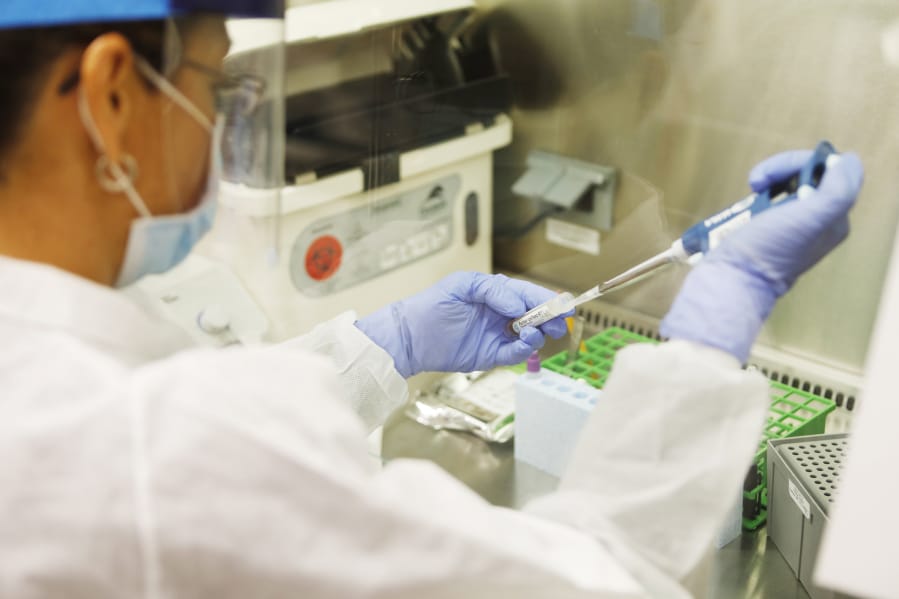U.S. laboratories have struggled for months to secure desperately needed supplies for COVID-19 screenings, but another testing crisis is brewing.
Other workhorse supplies are back-ordered too, hampering labs’ ability to detect urinary tract infections, sexually-transmitted infections like chlamydia and gonorrhea, gastroenteritis also known as the stomach flu and more.
That means longer turnaround times and less frequent testing. One Nashville, Tennessee hospital lab has been intermittently unable to screen for a bug that causes pneumonia since mid-June. Scientists worry this may cause doctors to miss disease-causing pathogens or prescribe more broad-spectrum antibiotics, leading to resistance.
Patients could also have complications from treatments prescribed without the proper tests. The alternative materials labs have had to use, meanwhile, could increase the risk of less accurate results.
“The impact of this supply chain is much, much greater than if we can’t get our COVID tests in 24 hours,” said Melissa Miller, who directs the clinical and molecular microbiology labs at UNC Medical Center in Chapel Hill, North Carolina. Miller has been told some products are back-ordered until January 2021.
Especially with flu season approaching, “I’m very worried, much more about non-COVID stuff right now,” she said.
Compared with the well-publicized shortages that have hamstrung U.S. COVID-19 testing, these supply challenges have gone largely unnoticed. But the two are closely tied: A months-long focus across the country on boosting coronavirus testing, paired with lengthy interruptions to non-pandemic medical care, left manufacturers prioritizing production of COVID-related materials. Companies like Becton Dickinson and Co and Hardy Diagnostics say they’re working to make up the deficits but it could take months.
An industry group has been tracking these gaps and communicating them to the federal government. But these issues likely won’t have the same level of political imperative as COVID-19 testing, experts say.
At Vanderbilt University Medical Center’s clinical microbiology lab in Nashville, Tennessee, a lack of solutions known as media, which help grow micro-organisms for use in screenings, has ground automated testing for antibiotic resistance to a halt.
“Now we have to do it the old, old way,” lab director Romney Humphries said. That means measure by hand, with a ruler, how close bacteria grow to an antibiotic on a paper disc. At 50 to 100 a day, that’s “1,000 different measurements you have to take and not make a mistake,” she said.
There are other shortages, too, including chemicals called reagents used to process tests. For three weeks in July, the lab couldn’t get media for yeast resistance testing. The other day, the whole lab had just 10 routine agar plates, used in screening for bacterial infections. Gonorrhea testing is seriously limited, and if things don’t change soon the lab will not be able to test for it at all, according to Humphries.
“It’s never-ending,” she said. “Myself and all the people in the lab are that way we’re just so burnt out. And there’s really no end in sight.”
Shortages of plates and media have broad-ranging implications because they’re used in lab cultures, a common means of growing micro-organisms in Petri dishes to diagnose infectious disease. Without staples like agar plates, labs have had to improvise, but it’s hardly ideal.
The analogy would be to baking: Without a measuring cup or spatula, an intrepid chef could find an alternative, but the outcome might not be as good. There may be substitutes for butter, for instance, but other items are essential to the recipe and can’t be so easily swapped.
What’s running low can change as often as daily, adding to the strain of managing supplies, said Robin Patel, past president of the American Society for Microbiology and an infectious disease specialist and pathologist at Mayo Clinic, which has a large reference laboratory that also performs tests for other organizations. In mid-August, the lab faced shortages affecting tests for lung infections in patients who have cystic fibrosis. That’s been resolved but they’ve having trouble stocking other tests now, she said.
“We’re caring for patients,” Patel said. “It’s not something that can wait.”
There are also overlapping shortages. Swabs aren’t just for COVID-19 tests they’re also necessary for a respiratory panel that looks for viruses and whooping cough. Pipette tips are also used widely.
Some items, like protective gloves and lab coats, are so common beyond the world of infectious disease that stretched supplies have affected labs that detect food-borne outbreaks, screen newborns and conduct environmental health testing. While a spokeswoman for the Association of Public Health Laboratories said the surge in demand hasn’t yet stopped anyone from getting test results, there’s been enough trouble locating supplies to cause worry.
“Many of us are concerned that not only are we going to have to deal with COVID, but outbreaks of other things along the way,” APHL Chief Program Officer Eric Blank said. Newborn screenings, for instance, need to be done within 48 hours of birth. “A delay for them would be disastrous.”
In mid-August, UNC’s Miller was nearly out of disposable plastic pipettes. She roamed campus for an hour in the heat, searching different research labs for them. Called transfer pipettes, they’re a basic material used to move specimens from one container to the next and an alternative to standard pipettes, which require the tips that are now in short supply.
Miller found some boxes, but expects to have to do it again soon. While it wouldn’t halt testing entirely, running out would be inconvenient, she said.
“We would just have to move to the next fire,” Miller said. “It’s kind of like whack-a-mole.”



